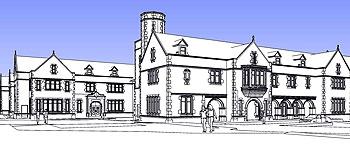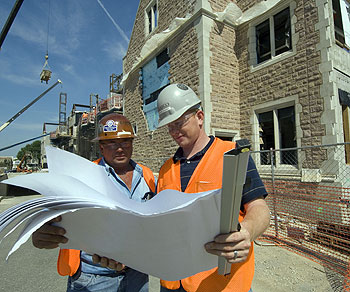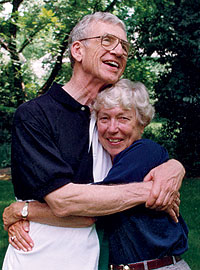Washington University will name its new university center in honor of Chancellor Emeritus William H. and the late Elizabeth (Ibby) Gray Danforth, Chancellor Mark S. Wrighton announced Sept. 19. The building is under construction on the University’s Danforth Campus at the intersection of Forsyth Boulevard and Wallace Drive.

The William H. and Elizabeth Gray Danforth Center, scheduled to open for the fall 2008 semester, will be a gathering place not only for students, but for the entire community — faculty, staff, friends, parents, alumni and visitors.
Constructed entirely in the Collegiate Gothic style, the three-story, 116,000-square-foot facility will feature dining areas, lounges, meeting rooms and offices for student leaders and student services professional staff.
“For so many of us and for such a long time, Bill and Ibby have embodied this institution. They have made an extraordinary impact on the past, present and future of the University, and we cherish this association,” Wrighton said. “There is no better way to honor their love for the University than to name the Center for them.”
The approximately $41 million facility was designed by Tsoi/Kobus and Associates of Cambridge, Mass., and is being built by Clayco of St. Louis. Communication Arts Inc. of Boulder, Colo., designed three dining areas and the center’s “fun room.” The construction is being supported in part by a gift from the Danforth Foundation. To date, A.G. Edwards and the Harry Edison Foundation also have provided leadership gifts for the project. Additional funding efforts are ongoing to provide the resources needed for the building.
“Ibby would be very pleased by having her name attached to this wonderful Center,” said Danforth. “I have countless warm memories of our years together at Washington University. She would see the new Danforth Center as a special place where students can gather with their friends and classmates for activities and talks, for learning and for growing.”
The building has been designed as a green structure, to be Leadership in Energy and Environmental Design (LEED)-NC Gold certified. It will have improved water and energy efficiency exceeding state and federal codes. Construction has included the use of many recycled products and materials and more than half of the construction waste will not end up in a landfill.
The building will feature dining and common areas, and will house the Career Center, event services and center management offices, graduate student space and the offices of the undergraduate student government, Student Union. There also will be studios for media groups such as the student-run television and radio stations. Offices for the Student Life newspaper, the yearbook and other publications are included. The Center will include office space for Campus Life, the department that includes administrative oversight for student activities, Greek life, community service and others.
The Great Dining Hall and the Common Area, including a massive Great Fireplace, will dominate the first floor. A café and a bistro with table service will add to the ambience. To the east will be a landscaped courtyard, which will include an outdoor fire pit and tiered seating.

Another focal point of the building will be the second-floor “fun room,” designed by Communication Arts Inc. with input from students. It will include garage doors that can be raised or lowered, movable furniture, chalkboard walls and high-tech audio-video equipment.
The building stands above the new three-story underground parking garage, two floors of which are open this fall. When the Center opens and all three floors are in use, the garage will have 522 total parking spaces for faculty, staff, student and visitor parking.
“Over the past few years, there has been a great need for a place for students to interact with each other outside of the classroom,” said Neil Patel, Student Union president. “The Danforth Center will be a huge asset to the student community because it provides us with a true student center that is tailored to us. There will be places to hang out after a tough day of classes, places to hold student group meetings and new choices for eating. And because of its central location, it will be easily accessible on a daily basis.”
“The Danforth Center is a building that will promote the activities important for the University as a community, a place where faculty, students, staff, alumni, parents and friends can come together,” said James E. McLeod, vice chancellor for students and dean of the College of Arts & Sciences. “It will enhance campus life with a special focus on our students. We have a wonderful design, and I think it’s being beautifully executed.”
“With the Student Union leadership and Campus Life functions together, the Center will serve students more efficiently and effectively,” said Jill E. Carnaghi, Ph.D., assistant vice chancellor for students and director of campus life. “The many and varied common areas, as well as meeting spaces, should make it easy for everyone to find a place they like within the building, or they can enjoy one of the three quadrangles that surround the Center.”
The Danforth connection
Perhaps no name is more recognizable than the name Danforth in building the success of the University over the past century.
The Danforth name has made an indelible imprint on the University — from William H. Danforth, an 1892 WUSTL graduate who established the Danforth Foundation in 1927; to his son, Donald Danforth, who served as chair of the Danforth Foundation from 1955-1965; to a grandson Bill (also named William H. Danforth) who served as chancellor of the University for 24 years (1971-1995); to another grandson, John C. Danforth, who chaired the Danforth Foundation upon his 1997 retirement after 18 years as Missouri’s U.S. senator and later as ambassador to the United Nations; to their sister Dorothy Danforth Miller, who has had a life-long interest in supporting education; to their late brother, Donald Danforth Jr., a 1955 WUSTL graduate who was executive vice president of Ralston Purina and a St. Louis civic leader.
On Sept. 17, 2006, the Hilltop Campus officially became the Danforth Campus to honor the legacy of William H. Danforth and his late wife Ibby, the Danforth family and the Danforth Foundation.
Nothing is impossible
Born in St. Louis on April 10, 1926, Chancellor Emeritus William H. Danforth was just 12 when his grandfather instructed him to literally cut the word “impossible” out of his dictionary. The lesson stuck. Danforth graduated from St. Louis Country Day School and spent a brief time at Westminster College in Fulton, Mo., before transferring to Princeton University and graduating in 1947.
He earned a medical degree from Harvard University, and after completing an internship in medicine at Barnes Hospital in St. Louis, he served in the Korean Conflict with the U.S. Navy from 1952-54. He returned to St. Louis to continue his medical training at Barnes Hospital and at St. Louis Children’s Hospital with leading Washington University medical faculty.
Danforth joined the Washington University School of Medicine faculty in 1957. He was named vice chancellor for medical affairs at age 39 in 1965 and worked with medical school Dean M. Kenton King to achieve the academic priorities of the school, helping to position it for great advances in the decades to come. He helped re-establish the critical working partnership between the teaching hospitals and the School of Medicine.
What he did in just six years to strengthen the medical center was merely a foreshadowing of what he was to accomplish as chancellor of Washington University during his 24-year tenure. As vice chancellor, Danforth stood alongside Chancellor Thomas Eliot and gave counsel to him during the student unrest of the 1960s.
Danforth was named the 13th chancellor when Eliot retired in 1971, and he served until his retirement on June 30, 1995.
Known as “Uncle Bill” and “Chan Dan” by students, Danforth and his late wife, Elizabeth, or Ibby, knew many students by name because of the countless campus events they attended and supported. The Danforth years reinvigorated student life on campus.
First-rate University
In a speech delivered on Founders Day in 1972, just his second year as chancellor, Danforth said: “My guess is that in the future, the United States will probably afford about 30 to 35 first-rate universities. Washington University certainly will be and must be one of these.”
Today the institution is ranked in the nation’s top dozen research universities.
“He envisioned a world-class future for Washington University; he set about attracting and retaining outstanding people; and he worked tirelessly to secure the resources that have made the difference between where the University was and what it became during his tenure,” Wrighton said.
In a 1977 letter to alumni, Danforth wrote: “From time to time, I try to figure out how our predecessors did it. They shared a grand dream that knowledge was better than ignorance, that humankind could be bettered by education. They did not feel that they were building for themselves but for their fellow humans and those who would come after. They believed that they could influence the future. And they did.”
By the time Danforth retired as chancellor in 1995 and was elected chairman of the board, his accomplishments were recognized nationally. He had set the course for the future of the University and completed its transition from a local college to a national research university, recruiting talented students and faculty from around the world.
Among his many awards, he was named “Man of the Year” in 1977 by the St. Louis Globe-Democrat and, like his predecessor Ethan A.H. Shepley (chancellor, 1953-61), was given the Alexander Meiklejohn Award by the American Association of University Professors for his unflinching support of academic freedom. He has a great devotion to the University and its founders, especially William Greenleaf Eliot and Robert S. Brookings.
A great citizen
“Ibby Danforth was one of the great citizens of Washington University and of St. Louis,” Wrighton said. “When she served as First Lady of the University, she actively supported Bill throughout his long career, engaging everyone with her warmth, intelligence, compassion and strength. Students especially appreciated Ibby’s presence and were impressed by her frequent attendance at classes, lectures, performances and athletic events.”

Ibby’s dedication to supporting University events on campus, in town and even around the world, drew admiration from alumni, parents and friends. Her name is linked to endeavors that reflect her exceptional spirit and commitment:
• the William H. and Elizabeth Gray Danforth Scholars Program, which honors students in all areas of the University who have outstanding character and are committed to service;
• the Elizabeth Gray Danforth Scholarship, for a transfer student from the St. Louis Community College District, from the Women’s Society of Washington University;
• the Elizabeth Gray Danforth House, a freshman residence hall;
• the Elizabeth Gray Danforth Butterfly Garden — known as Ibby’s Garden — created by the Woman’s Club of Washington University;
• the Raymond E. Maritz Professorship in Architecture, from William E. and Jackie Maritz, in Ibby Danforth’s honor;
• the Roy and Diana Vagelos Professorship in Biochemistry and Molecular Biophysics, from Dr. P. Roy and Mrs. Diana Vagelos in honor of William H. and Elizabeth Gray Danforth; and
• as a member of the Washington University Sports Hall of Fame, as is William H. Danforth.